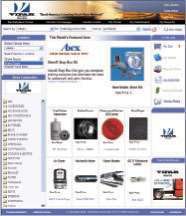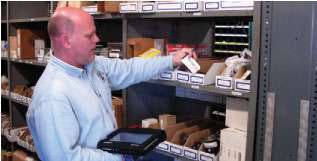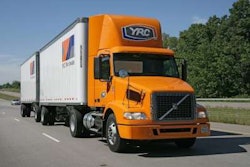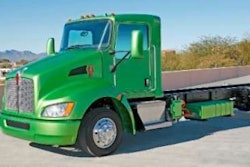 An online catalog tool from Vipar Heavy Duty enables fleets to standardize parts purchasing for multiple locations.
An online catalog tool from Vipar Heavy Duty enables fleets to standardize parts purchasing for multiple locations.In 2007, Steve Womack was looking for a new software system to manage the parts inventory of Service Rock Products. His current system was not keeping pace with the company’s growth. Parts were running out of stock, and complaints were piling up.
“All of the data was put in after the fact,” says Womack, shop supervisor for the Victorville, Calif.-based ready-mix concrete and aggregate producer. “Information was often a week old.”
Service Rock Products operates maintenance shops at 11 of its 18 locations that serve the high desert areas of southern California, Las Vegas and surrounding communities. “I used to get complaints from our mechanics that they didn’t have the parts needed to complete repairs, and operators or plant managers would complain about repair delays or repairs that didn’t get done,” Womack says.
To improve inventory management, the company implemented Kenworth’s PremierCare Connect, a Web-based fleet maintenance system. Today, Womack has live inventory information for each location, and stockouts have been virtually eliminated.
But at what cost? Keeping a healthy supply of spare parts might improve technician productivity and minimize vehicle repair times, but in a strapped-for-cash low-margin business such as trucking, inventory represents precious capital that is not earning a return.
However, by using fleet maintenance software to optimize inventory, fleet managers like Womack are able to both save money and keep assets rolling.
Buying parts
Parts management systems will answer four questions about every item in inventory: where it came from, what it cost, where it is now, and how many are left. To help ensure data entry is accurate and efficient, fleets typically use barcodes and scanners to receive items into inventory and to attach items to repair orders.
Besides keeping accurate inventory records, most systems can track the warranty period of each item. If a part is replaced on a vehicle within the warranty period, the system flags the item and prompts technicians to initiate a claims process.
In the cases of managing parts inventory and recovering dollars from warranty, technicians must operate within a tightly controlled system. Software can help make this system seem intuitive to technicians by using acknowledged standards to organize the physical inventory.
Vehicle Maintenance Reporting Standards (VMRS) is a common coding convention that many software systems use to identify parts and maintenance activities. VMRS codes identify parts by their location on a vehicle and, as such, provide an intuitive way of locating parts on shelves and in bins.
Another way to improve technicians’ confidence in the system is to ensure the software has accurate inventory counts. To perform a physical count, fleets typically will print a list of items in inventory by VMRS codes and note any discrepancies.
The latest versions of fleet maintenance systems can be deployed on wireless handheld computers, PDAs and cell phones. A worker can enter a parts room with a handheld computer, scan a barcode on a part or a bin, enter the piece count and move to the next item by VMRS code.
Before Hagey Coach and Tours changed to the Dossier fleet maintenance management system, the Souderton, Pa.-based company did not have the convenience of using a handheld and wireless network to manage parts inventory. Now, a Hagey technician enters the parts room holding a tablet PC or a PDA with built-in scanners. With Arsenault Associates’ Dossier system running on the computers, the technician can make changes immediately, such as adjusting part counts or the location of items on shelves, says Bob Nolen, fleet manager.
To eliminate tedious work such as tracking items like bolts or electrical connectors that fall below a certain dollar amount — for example, $5 per item — many companies will diversify the bulk cost of these items over an entire fleet. The Dossier system tracks these miscellaneous items in a category called “X factor” that can be applied to fleet maintenance costs in various ways, such as on a per-mile basis, says Charles Arsenault, president.
Optimizing orders
Once data entry is tightly controlled and accurate, fleets can use reporting tools to fine-tune their inventories by analyzing parts usage and establishing min-max parameters for each part they keep in stock.
TMW Systems recently added a feature to its TMT Fleet Maintenance software system to adjust these min-max levels automatically by using historical parts usage data to forecast demand. “Just like any other management system, we’re doing calculations for the customer to optimize the min-maxes,” says Scott Vanselous, general manager of TMW Systems’ Asset Maintenance division.
In fleet maintenance software, the min-max system is the standard way to automate the reorder processes. Fleet maintenance software systems will notify personnel when the quantity of a part reaches or falls below the minimum level and will calculate a reorder quantity — the maximum level minus the current quantity.
At Hagey Coach and Tours, a Daily Reminder dashboard in the Dossier system shows Nolen what parts to order, as well as all other daily tasks to be completed. Nolen also monitors parts usage periodically to look for any seasonal or abnormal changes that may necessitate adjusting his min-max levels. If he notices a drop in usage for a certain part, he can use Dossier to look up the make/model of the vehicle that the part fits. If the number of these vehicles has declined recently, Nolan will change the min-max levels so as to not order the part again.
“That way, you don’t end up with obsolete parts on hand,” he says. “We are a lot more in touch that way than before.”
Likewise, PremierCare Connect has helped Womack identify slow-moving items in inventory and any excess parts that can be returned to suppliers in exchange for faster-moving items. “We are spending more time cleaning up inventory,” he says.
Easy shopping
Fleets also can improve maintenance efficiency by using a parts management system to purchase parts for one or multiple locations.
At Hagey Coach and Tours, the purchasing process consists of printing a list of the parts that need to be ordered each day from the Daily Reminder screen in Dossier. For each part, the list shows the most recent vendor and price. The Dossier system also cross-references the part numbers with vendors from all previous purchases.
“If I have an item that I’m going to buy a decent amount of and want to get a decent cost, I can look back and see what I paid with all the different vendors and get quotes from them,” Nolen says.
Fleets using TMT Fleet Maintenance can send a purchase order from the software directly to a vendor through e-mail, fax or electronic data interchange. The purchase order includes all part numbers, quantities and the last approved cost for each item.
When parts are received at the shop, a parts manager quickly can match the price and quantities of each item on the packing list with the information from the purchase order in the software, says Dave Walters, technical sales manager for TMW Asset Maintenance.
Peterbilt, Kenworth, Navistar and Daimler Trucks offer software systems to streamline the processes for ordering parts from their respective dealer networks.
Paccar Parts offers the Peterbilt TruckCare Connect and Kenworth PremierCare Connect Web-based fleet maintenance management systems. The software gives fleets an auto-replenishment feature for parts from their local dealership. The system automatically e-mails the dealership with a list of parts to be restocked.
Customers typically use the feature for fast-moving parts such as filters and brake drums.
Last year, Paccar Parts introduced a 1 percent loyalty rebate program for parts ordered through the system to dealers. The company renewed the program this year.
Navistar’s fleet maintenance software system, Diamond Connection Solutions, has an optional auto-replenish/auto-order function that customers can use to transmit orders automatically to their local International dealers for same-day and next-day delivery.
The system gives recommendations for min-max levels based on parts usage and purchase history, and customers can decide if they want to auto-replenish items, says Greg Baze, marketing manager for Navistar Parts.
Daimler Trucks’ Web-based ordering tool, PartsCart, allows customers to look up parts and add them to an online cart, and then verify nationwide pricing and availability of those parts in real time. To speed future parts orders, customers can build a “favorites” list of previously ordered parts.
Customers also can access PartsPro, Freightliner’s electronic parts catalog, from within the PartsCart system, allowing them to access serialized parts information and import a list of parts to PartsCart for easy ordering.
 Thanks to the Dossier system from Arsenault Associates, Hagey Coach and Tours Fleet Manager Bob Nolen can use a handheld and wireless network to manage parts inventory and make changes immediately.
Thanks to the Dossier system from Arsenault Associates, Hagey Coach and Tours Fleet Manager Bob Nolen can use a handheld and wireless network to manage parts inventory and make changes immediately.Fleets sometimes will use separate software systems to purchase parts and manage parts inventory. But these so-called “third-party” purchasing systems may not have the checks and balances provided by fleet maintenance software, such as the capacity to apply cross-references to part numbers, equipment specs and vendors.
By using fleet maintenance software to cross-reference part numbers, the corporate office can build a central parts catalog — a list of pre-approved part numbers — for separate places to order parts.
Venezia Bulk Transport has been using the TMT Fleet Maintenance system to manage parts inventory since 1999. Since implementing the software, the Limerick, Pa.-based company has reduced inventory by 15 percent and increased warranty recovery by 15 times.
Since using the TMT Fleet Maintenance system, Venezia Bulk Transport has hired a corporate-level parts manager who purchases parts for all of the company’s 10 maintenance facilities. “Individual shops don’t make the decision on what to buy,” says JP Venezia, fleet warranty and systems manager. “We brought everything in-house.”
The TMT system keeps a detailed record of inventory at each location and a history of equipment repairs. If the purchasing manager needs to buy an alternator for a certain truck but one is not in stock, Venezia quickly can find the part number by searching the repair history of an identical truck in the fleet in which the alternator was replaced.
Some vendors have created e-commerce platforms to provide fleets with centralized purchasing controls. Vipar Heavy Duty, a national parts marketing and buying network that consists of 115 distributors in North America, has an e-commerce platform, v-Enterprise, that customers can use to purchase parts from an online catalog as well as transmit critical order information electronically.
Vipar Heavy Duty offers national account programs. Fleets can spec particular products from the catalog with uniform pricing on a nationwide basis. The v-Enterprise platform gives fleets the visibility to ensure that the pricing delivered from the distributor to the fleet is within the range agreed to by the fleet.
Some fleets tie their fleet maintenance and purchasing systems directly to v-Enterprise. Fleets that decide to leave purchasing decisions to local shops still can use the reporting capability of v-Enterprise; when a local shop calls a distributor to order parts, the distributor can put the order information into v-Enterprise.
Using technology to reduce costs and improve inventory efficiency can preserve cash and improve vehicle utilization. As the economy struggles to recover, fleet maintenance managers are leveraging technology to make every dollar — and part — count. n
Outsourcing is within
The City Garage of North Charleston, S.C., turns its parts room over to Napa Parts
With many parts distributors vying for your business, you may wonder if the cost and effort it takes to manage inventory is in your best interests. Regardless of what software system you use to manage inventory, stocking parts ties up cash and will require significant data entry and file maintenance.
The City Garage of North Charleston, S.C., decided to outsource its inventory to Napa Parts. “We determined that it would be a mutual benefit to them and a savings to us,” says Jerry Glass, fleet manager.
The City Garage of North Charleston maintains about 650 pieces of rolling stock. The department used to carry about $75,000 in inventory. The items in stock mostly were “essentials” such as filters and brakes. Not included in this amount were the ongoing labor costs to operate a parts room, inventory shrinkage and other embedded costs such as sending a technician to buy parts when the department did not have an item in stock.
The City Garage signed an agreement with Napa to locate a store within its building. As part of the agreement, Napa guarantees a 90 percent on-demand inventory. The City Garage is on a flat-rate contract with Napa for cost plus 10 percent.
“We supply them with space and access to be able to do that,” Glass says. “Napa has local stores they use as a backup supply system.” Napa even took possession of the city’s existing inventory and “sold” those parts back to The City Garage at zero cost. Napa paid The City Garage for any parts it acquired that the City did not use, Glass says.
The City Garage also added an electronic interface between its Dossier fleet maintenance software from Arsenault Associates and Napa’s software system. The interface automatically will post parts to the work orders created in Dossier at the same time Napa sells a part over the counter to a technician.
“I can comfortably say this has been very beneficial for city and taxpayer to enter into this arrangement,” Glass says. “I don’t see any reason why we should change.”













